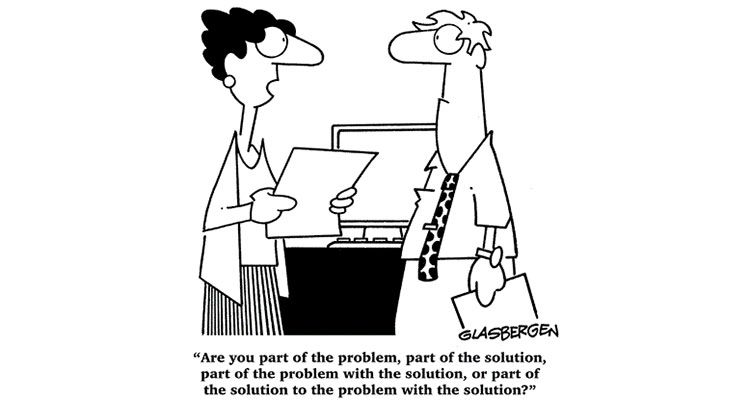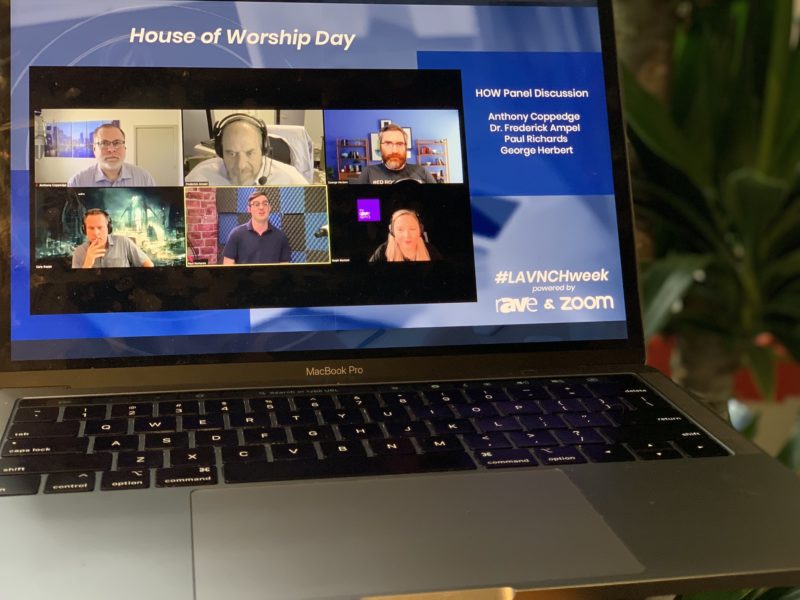Solving the Problem, Part One

Courtesy of Randy Glasbergen – ©RandyGlasbergen.com
Over the past few months, my esteemed rAVe HOW colleague, Anthony Coppedge, has written several columns that raised significant and critical issues regarding the supply of and sales of AV hardware and related products into the house of worship markets. His focus has been on the issues facing integrators and why many of them are essentially the result of self-fulfilling mindsets and practices.
I would like to expand on those points but from a different perspective and hopefully augment Mr. Coppedge’s valuable advice in a two-part series, of which this column is the first part.
(Anthony’s posts can be found here and here.)
The perceived difficulties in selling to the HOW market are certainly evident in the approach of many suppliers, manufacturers and AV integrations, but I believe that there is a deeper and more pervasive issue underlying this problem.
Discovering the Problem
From our perspective, the issue underneath all “issues” supposedly hindering effective sales and service of the AV needs of the HOW market is a lack of understanding of how to discover, evaluate and then actually solve the problems of HOW clients/users. Inherent in this is a further failure to understand how to properly conduct and complete a valid needs assessment of those customers.
It is crucial to recognize that the needs assessment required is not just technical in nature — it is also operational, structural and personnel-related as well, and it is the non-inclusion of these elements that leads to failure in the HOW market.
Seeking a Solution
In the pantheon of business skills and techniques, there is a well-established and often-quoted methodology to create a logical path to a viable solution, as well as provide a framework for a proper needs assessment. This process, commonly known as the “Seven Step Method,” is illustrated by the graphic below.

The Seven Step Method. Image via BrianCram.
The Seven Steps version discussed below originally appears in an article here.
Almost every HOW project can and will benefit from the application of your own personalized version of this approach. The steps discussed below are guidelines, not rules, so you can and should adapt them to your business’s style and your people’s capabilities. The Seven Step Method although quite simple, is both methodical and effective when consistently applied and completed.
Getting the Information
The circle graphic (above) shows the process of using the seven steps to gather accurate and clearly delineated information on the problem the client is trying to solve and how to take that information and create a viable plan of action to deliver a solution that both meets the needs AND creates satisfaction among all project stakeholders.
It is this total buy-in on a project that often eludes integrators/consultants and other trade professionals. I have lost count of the number of times we have been witness to the problems created when an assumption of acceptance is made — i.e., the leader(s) agree but nobody bothered to verify that all the other stakeholders involved — especially those who may not be front and center in meetings or discussion — also are on board with the plan.
Our solution is to create, at the start of every project a complete list of all “voting” members of the client/user’s group. To do this you need to ask questions and ask them again to be sure you have collected the names, roles, titles, and decision-making authority entrusted to or assigned to EVERY member of the stakeholder group.
Whenever the primary decision-makers have agreed to something we always ask them to verify that everyone else is also on board. If they don’t we reach out directly to ensure we don’t find out there is a problem after the fact. But…. be careful if you use that approach- careful to let the primary decision makers know you are reaching out to all the others, so no negative perceptions are created.
Building the Solution Matrix
Using the steps process you need to diligently undertake data collection and information verification for each step before moving onward. Here is a numerical list of the steps and actions needed:
Define the Problem
Sometimes the stated problem not the real problem. This is the point at which most troubles start. DO NOT take the “stated” problem as a fact. Check, verify and and verify again that what you are being told is actually the problem and not just a part of the problem, or a perceived problem hiding the real issue or a misstatement of a technical issue because of lack of knowledge. You are being hired for your expertise, so provide it.
Define Objectives and Performance Measures
Once you are absolutely sure you understand what the problem is, you need to develop and present a very clear and defined statement of the outcome you intend to deliver. And that’s in plain language — NOT TECHNOBABBLE! Knowing what your client expects (something you should have determined by this point) will ensure that what you offer will match up to expectations AND actually solve the problem — you need to hit both goals to be successful.
Identify the Boundaries and Constraints
The unstated rules and boundaries, both fiscal and cultural, are a major tipping point in this process — one you can avoid by being absolutely certain you have asked enough questions and gotten enough information to be completely ceratin sure you know what those “edges” are and who controls them! It also prevents a classic case of overselling or overreach — i.e., when you present a solution larger and more complex (or expensive) than is really called for.
Identify, Generate and Prioritize Options
You must build a priority and options matrix for any solution you offer: First, what MUST be done and second, what else CAN be done that is useful but adds cost or time. If you define your solution in this format, it ensures that the client becomes actively engaged and feels they are in control of the final solution and all options.
Develop Options into a Plan
Once it is clear which options are wanted and or feasible, flesh out any details and be completely certain that everyone agrees to the options and understands the expected result, benefits and impact on the project as a whole.
The Finish Line: Implement the Solution
You finally made it to the point where actual work can begin. Now you have to decide and get agreement on the process itself. How are you going to get to the end result while getting everyone to recognize that some parts of the process are simple but others can be wide-ranging and require significant effort to deploy? Be sure everyone understands the difference.
And Finally: Evaluate the Outcome and Ensure the Problem is Solved
This should actually be an on-going process through the whole project timeline: Make sure each step is delivering the desired results and if not stop and find out why so you can fix it before you move on. Only in this way can you be comfortable that when all is said and done, the desired result will have been achieved and all expectations met.






